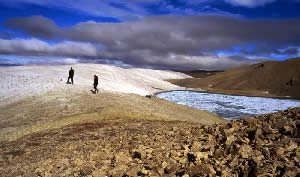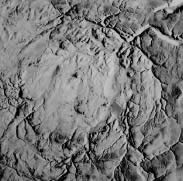Mars on Earth
by Pascal Lee


Geologists examining a breccia hill.
 |
|
Mars today is mostly a cold, windy, barren, rocky desert,
with many ancient impact craters, channels, valleys, canyons,
possibly ancient lakebeds, and many other features. No place
on Earth is truly like Mars: on Mars gravity is weaker, the atmosphere
is thinner, drier and made of carbon dioxide (CO2),
radiation from space is more intense, temperatures can be much
colder. But the polar regions on Earth come close in some respects.
On Devon Island in the Canadian High Arctic, there is
a unique combination of circumstances: an ancient impact crater
(Haughton Crater) set in a cold, windy, barren rocky desert,
with nearby channels, valleys and canyons that bear a strong
resemblance to many of the channels, valleys and canyons seen
on Mars. What then can we learn about Mars by studying
Haughton and Devon? What can we learn about how to explore
Mars with robots and humans? To answer these questions,
the NASA Haughton-Mars Project began studies in 1997
and has visited the site every year since. Devon is turning out
to be a Mars analog
wonderland and is the
site chosen by the Mars
Society to establish its
Flashline Mars Arctic
Research Station.


Aerial view of Haughton Crater
 |
|
Haughton Crater
is 20 km in diameter
and formed 23 million
years ago (Miocene).
The exact size
and speed of the impactor
are unknown,
but it may have been 0.5 mile across and travelled at several
tens of kilometers per second. At the time of the impact the
Earth was warm and Devon had a climate somewhat like that
of Toronto today. There were trees (conifers, leaf-bearing trees)
and many animals (a little Rhinoceros, rabbits, fish). In an instant,
all life at the site was wiped out. From a biological standpoint,
the impact was a resetting event on at least a regional
scale, and biological studies at Haughton are very important,
even if there were no Mars connection. The rocks that were
impacted (mostly ancient marine sediments over 300 million
years old, replete with fossils, some of primitive corals and
stromatolites) were in part vaporized or crushed
and ejected from the crater. Even basement rocks
from about a mile deep were excavated and
launched into the sky. As the ejected rocks rained
back down, heaps of impact rubble accumulated
to form the beautiful Haughton impact breccia,
still well preserved today.


A polar bear taking at a stroll at the periphery of Haughton Crater.
 |
|
The Haughton breccia is now permeated
with ground-ice and may provide the closest natural
analog to the martian regolith (the surface
rubble on Mars generated by impacts). By studying
the breccia, we might for instance learn about
the possible distribution of subsurface ice on Mars. After the
impact, temporary hydrothermal vents became active in and
around the crater. They provided isolated sites of enhanced moisture
and warmth and are therefore of great biological interest.
Might similar impact-induced ancient hydrothermal vents be
found on Mars? Water also collected inside Haughton crater
and lake sediments were deposited. The lake waters eventually
drained away but the ancient lakebeds can still be found. By
studying these lakebeds, we can learn how to recognize possible
counterparts on Mars, sample them and study them for
their climatic and fossil record. There are also the many channel
networks, valleys and canyons outside Haughton Crater.
Most of these were formed in direct connection with past glaciations,
either by direct glacial carving or by the melting of
glacial ice. If the valley networks and canyons on Mars were
formed in a similar way, then there might be no reason anymore
to invoke a warm climate on Mars in its past. Our studies on
Devon are opening the alternative perspective that Mars may
have always been climatically cold, albeit wet at times, not
"warm and wet". What would that mean for its prospects for
harboring life? At Haughton, microbial life proves to be very
adaptable and can be found almost everywhere - inside rocks,
at the bottom of ponds. Even if Mars was always cold, its
propsects for having possibly evolved life remain very good.
In all our wanderings on Devon we are also learning
how to explore Mars with humans. We test communication systems
with imposed time delays for links with Mission Control,
we try out new robotic technologies, new spacesuits, we study
human factors and a variety of other exploration technologies
and strategies that are essential to understanding how a human
mission to Mars can be successfully carried out. The Flashline
Mars Arctic Research Station will serve in this context as a
very valuable operational
testbed, a realistic
framework for constraining
how humans
will have to live and
work on Mars to be effective
explorers. Our
work on Devon will
represent an important
step in the direction of
getting humans to
Mars.
|

